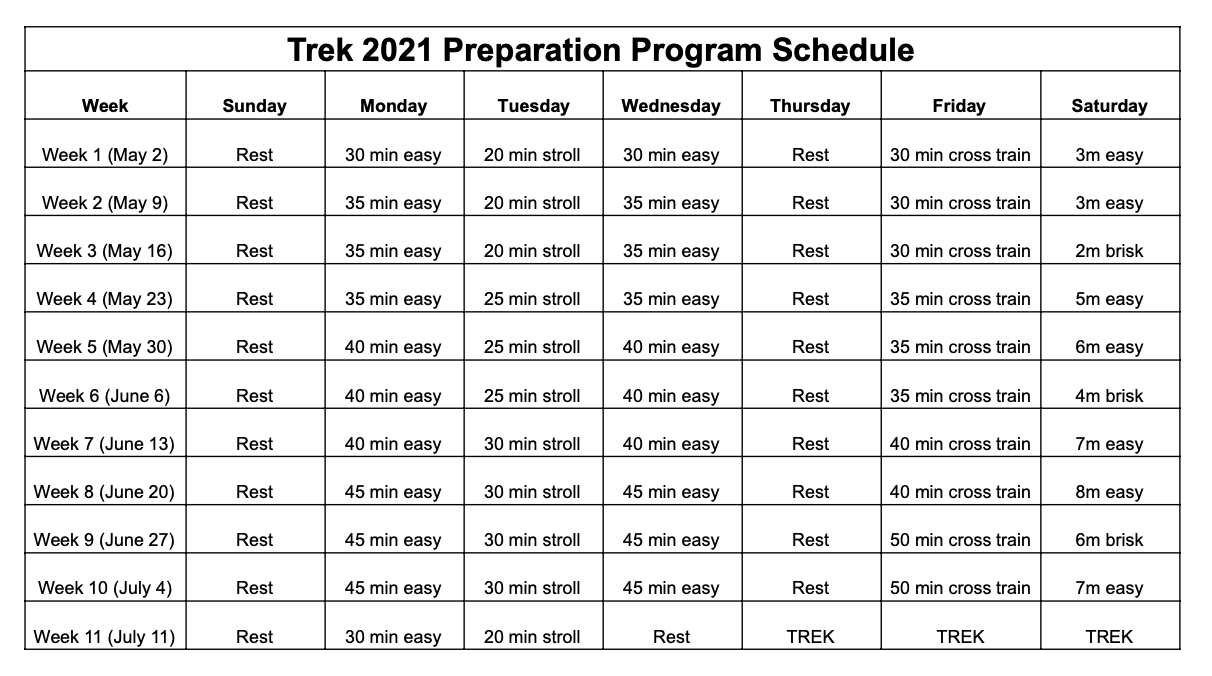Physical Preparation
What should participants expect?
- There will be a series of hikes over three days totaling 21.7 miles.
- There will be regular, frequent, and monitored water breaks with water available along the trail at all times.
- We expect all participants to be able to complete the hikes (and their trek family will be there to help!)
Safety while on the trek:
- A medical team will be present along the trail and at checkpoints.
- The primary role of healthcare personnel will be to monitor and prevent any common ails (such as dehydration, blisters, etc.).
- There will be a first aid cart for any minor injuries (unexpected).
- To prevent blisters, it is important for the youth to wear quality socks and wear only footwear that is well broken in (preferably that they have worn on at least one 10+ mile hike).
Trek 2021 Preparation Program Schedule
Here is a suggested training program adapted with permission from Hal Higdons who is a world class marathoner.

Download the Trek Training PDF
Incorporate pushups and sit ups into weekly routine at least 3 days per week. You should begin small and gradually advance your activity level. Be sure to drink water at least every 20 minutes during your walks! Make sure to have comfortable walking shoes that will be able to counteract sharp stones. To help prevent blisters it is strongly suggested that your hiking shoes are broken in well in advance of Trek. It is also suggested to wear two pairs of socks with the inner sock being a thin synthetic blend and the outer sock a thicker wool blend.
How much do you need to train?
Some individuals who possess a reasonably good level of fitness (because they bicycle or swim or participate in other sports such as soccer) could probably go out and walk 15 miles with very little training. They may be sore after the hike, but they still could finish. For those unsure of what to do to get in shape, above is a 14-week training schedule to help prepare you to complete the Trek. It assumes that you have no major health problems, are in reasonably good shape, and have done at least some jogging or walking prior to beginning the program. The program is designed to prepare people to walk a half marathon which is 13.1 miles. The terms used in the training schedule are somewhat obvious, but Mr. Higdons explains what he means.
Stretch & Strength
Mondays are the days in which you should do some stretching along with some strength training; this is actually a day of rest following your weekend long walk. Do some easy stretching of your leg muscles. This is good advice for any day, particularly after you finish your walk, but spend a bit more time stretching on Mondays. Strength training could consist of push-ups, pull-ups, use of free weights or working out with various machines at a Health Club. Walkers generally benefit if they combine light weights with a high number of repetitions, rather than pumping very heavy iron. He suggests that you do some strength training following your Thursday workouts, however you can schedule strength training on any two days that are convenient for your business and personal schedule.
Cross Training
What form of cross-training works best for walkers preparing for a 15 mile hike? It could be swimming, or cycling, walking, other forms of aerobic training or some combination that could include strength training if you choose to do it on Wednesdays and Saturdays instead of as indicated on the schedule. And feel free to throw in some jogging as well if you’re feeling strong. What cross-training you select depends on your personal preference. However, don’t make the mistake of cross-training too vigorously. Cross-training days should be considered easy days that allow you to recover from the walking you do the rest of the week.
Rest
The most important day in any walking program is rest. Rest days are just as important as training days! They give your muscles time to recover so you can run again. Actually, your muscles will build in strength as you rest. Without recovery days, you will not improve. In this program, Sundays and Thursdays are always scheduled as a day of rest to compliment the also easy workouts on Mondays.
Long walks
The longest walks of the 14-week schedule are planned for Saturdays, since you probably have more time to do them on the weekends. Keep them at a “conversational” pace; meaning, at a pace slow enough that you can converse with a walking companion without getting too much out of breath.
Step Back Weeks
You will notice that the weekly mileage does not progress upwards in a straight line. In some weeks, you walk somewhat less than the weeks before. This is the “stepback” approach that he first began using with his marathon training programs, giving walkers a brief break every third week so that they could gather strength before pushing up to the next level. If it works for marathoners; it works for 15 mile walkers too!